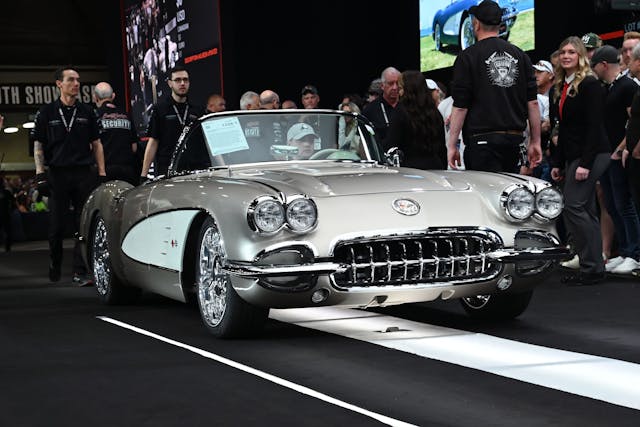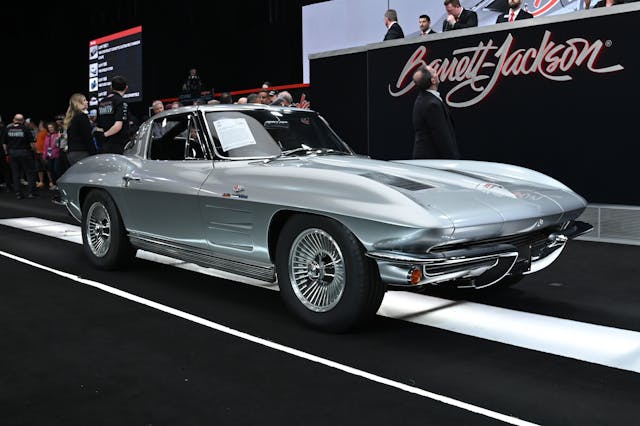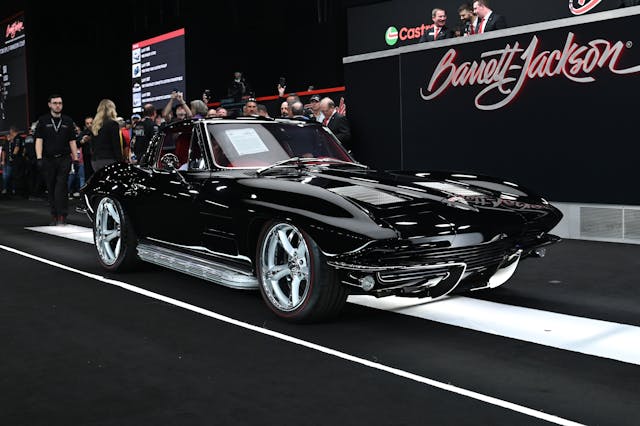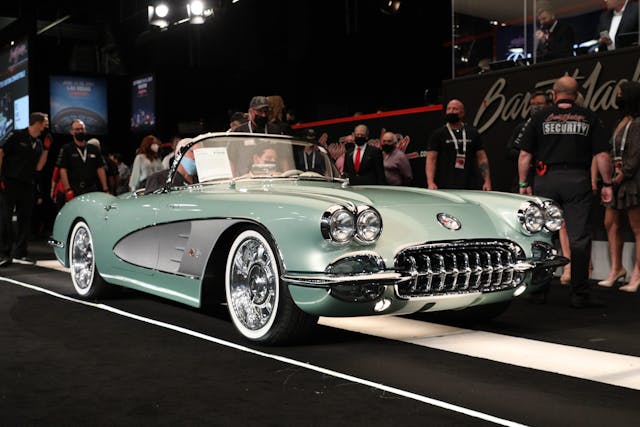For These Corvettes, the Stock vs. Modified Debate Has a Clear Winner
At Barrett-Jackson’s marquee Scottsdale auction last month, two trends stood out. They both have to do with custom cars. First, the sheer quantity of customized vehicles was overwhelming. Second, the customs consistently brought more—sometimes much more—than their stock year/make/model counterparts, even ones restored to factory specifications. Tradition dictates that modifying your car doesn’t add value to it and indeed often detracts from its value. The results at Barrett-Jackson, particularly for several vintage Corvettes, seem to fly in the face of that tradition.
First, some background. The term “custom car” has evolved over the past twenty years. In the past, it referred to re-imaginings in the tradition of Ed “Big Daddy” Roth. They were extravagant, fanciful, and creative. They displayed little of the original car they claimed as a starting point and nodded more to cartoons than to anything seen on the roads of the real world. Over the past couple of decades, those customs have merged with a new and increasingly popular category called “restomod.”

Coined by the team at Barrett-Jackson—Craig Jackson, Steve Davis, and Gary Bennett—in the mid-2000s, restomod refers to cars that are mostly stock-appearing on top (aside from a lower stance and large modern wheels) but have completely new underpinnings. Twenty-first-century drivetrains, upgraded suspension and brakes, and comfort features like modern air conditioning are the main ingredients. The end product is supposed to feature the performance, safety, and reliability of a new car while retaining the style and presence of a classic. These make up the majority of “customs” today, which have little connection with the creations of “Big Daddy” Roth.
Where buyers buy, builders build. For buyers and builders of restomods, Barrett-Jackson Scottsdale has increasingly been the go-to auction event. This has set up a contrast between the “customs” and their restored, stock-configured counterparts. The customs are winning the battle of the bids, and they were ubiquitous at WestWorld.
Custom Corvettes were particularly abundant, and two pairs exemplify the contrast between factory-correct and thoroughly customized. The customs are fresh, professionally built, and gorgeous, but the restored cars aren’t slackers, either, and both the stock Corvettes sold at prices appropriate to their condition, options, and documentation. In each case, though, the customs won out by a large margin.

First, the pair of 1958 Corvettes—Lots 1108.1 (stock) and 1338.1 (custom). Lot 1108.1 was a factory-correct black-over-blue car with a 283 cubic-inch, 270-hp dual-quad engine, four-speed manual, hardtop and soft top, heater, and radio. An older restoration, it showed some age and miles but was still close to showroom condition. It sold for $220,000.

Lot 1338.1, meanwhile, was painted in Cashmere over Linen leather and although it had a 1958 Corvette VIN, the chassis underneath was a modern frame by noted builder Art Morrison. It also featured a 6.2-liter LT1 engine from a 2023 Corvette as well as an automatic transmission, adjustable coilovers, 19-inch alloy wheels, Wilwood disc brakes, and air conditioning. Aside from some fit issues with the windshield and door posts, it was a gorgeous, comfortable, and surely exhilarating ride. It sold for $440,000—double the final price of the factory-correct ’58.

Then there were the 1963 coupes, lots 1363 (stock) and 1363.1 (custom). Lot 1363 was a Sebring Silver over black vinyl split-window coupe restored to like new. Not only that, it was a rare Z06 Competition model, which in 1963 got you a 327 cubic inch, 360-hp fuel-injected engine, Positraction rear end, heavy-duty shocks, larger front anti-roll bar, and upgraded brakes. It was Bloomington Gold certified and has been awarded NCRS Top Flight. A genuine Z06 is among the most valuable early Corvettes, and this one sold for $330,000.

Lot 1363.1, the very next car across the block in WestWorld, was another split-window coupe finished in black over red leather. Its modern drivetrain was made up of a Wegner LS9 block, an LT4 crankshaft, a Magnuson supercharger, and a Tremec T56 6-speed manual. It rode on a low chassis frame, also from Art Morrison, as well as coilovers and a multi-link suspension. Other upgrades included Wilwood brakes, Schott alloy wheels, Vintage air conditioning, and Recaro seats. It sold for $412,500.
The contrast goes beyond price because these are of course very different vehicles despite sharing the same year/make/model. The restomods are fresh and beautiful but also up-to-date in their performance and luxury equipment. They are each unique statements of style and exclusivity. Their appeal is immediately apparent, though they may only be driven a few miles to a show or in a parade, then exquisitely detailed to remove all traces of dust, dirt, or—God forbid—mud. But as they age, even with limited and careful use, their “edge” will soften. Patina is not the friend of the restomod. A digital touchscreen from 2024 in a 1964 Corvette may look awkward and out of place in 2044.
Factory-correct restored cars age and lose their edge, too, but to a far lesser extent. Should the restored cars get used to the point where they show patina, the act of re-restoring them can also help boost their value once more. Owning one of these Corvette customs is surely a satisfying experience, not only for the feeling behind the wheel but also for possessing a singular, intricately assembled, and detailed creation with a special combination of style, power, technical sophistication, and performance. Owning one of the carefully restored original configuration Corvettes is less distinctive, but also less subjective and more historically relevant as an authentic, unmolested piece of the era that produced them.
Different versions of the same car for different buyers, then. But the collector car market, which has long favored authentic factory-correct above all else, is now embracing custom creations with open arms.
***
Check out the Hagerty Media homepage so you don’t miss a single story, or better yet, bookmark it. To get our best stories delivered right to your inbox, subscribe to our newsletters.



Custom, mild custom, restomod, Strauss Stores custom… Yech. The most modified parts on my ’63 Bonneville convertible is the single wire electronic ignition system (from Lectric Limited) contained entirely under my distributor cap and my Diamondback radials (with period correct whitewalls).
My dad bought the car in January of ’65, and she’s more a member of the family than a mode of transportation. She is a time capsule of my childhood, the first car I ever “owned,” my high school wheels, my first show car… Modifying her in any way would be like proposing a nose job to Marilyn Monroe…
My daily driver (a 2006 Cadillac STS-V) is similarly stock-stock except for Continental tires vs the hard-riding Pirelli run-flats as originally delivered with the car.
As others have pointed out, it will be interesting to see how these 2024 creations fare in 20 years, when my ’63 Bonneville convertible will still look like she rolled out of a showroom in 1963 and these other things look like ghastly kit cars bolted, welded, and screwed together with today’s technology.
Wakman – ” I agree , to an extent” The 69 is my favorite too. Doing some mods to improve real world driving is fair enough especially if they can be undone by a purist. No harm, no foul just save those original parts. And when you think about it that has been going on since these cars came out. I like period correct performance goodies for instance. Still a Coyote..in a Mach 1…that’s a CJ. , SCJ car every day of the week and twice on Sunday. Loose that big block, loose that vibe. A bridge too far. Besides you’ll have to modify the shock towers to get it to fit, then you’re cutting, grinding and welding and the next thing you know…you might as well just finance a Dark Horse.
I wandered thru this post and I’m perplexed.
If it ain’t stock., it’s custom/modified!
Restomod means someone had the cajone’s to hack up up a stock car to make what they wanted.
I have no objection to that (in fact I am in favor of it), but I grew up with the t-shirt that said “if it don’t go, chrome it!”
Over the last few years, the only folks who worry about what label is put on the car is those who are paying attention to the selling price (and their ROI), and I do not believe they they are not real car folks, just profiteers.
Keep chopping them up and Restomoding them, it makes the people with original or restored to original cars more valuable. They only made SO many!